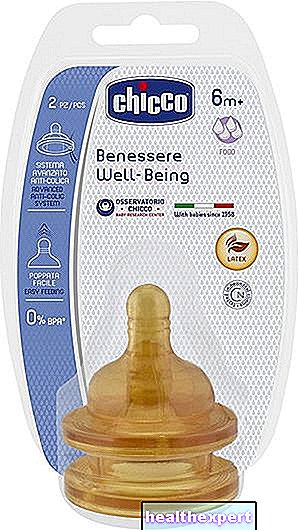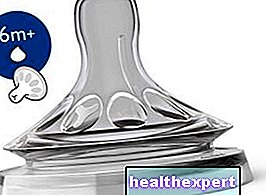Bottle teat: the most suitable for artificial feeding
How to choose a suitable pacifier for your child? When preparing to welcome a baby into the home, the choice of bottles and teats must be made with extreme care, whether you decide to breastfeed or opt for bottle feeding.
After making sure that the teat is compatible with the bottle (some have a wider base than others), you can choose the one that seems more efficient, functional and comfortable.
Ergonomic, in silicone, rubber, with round tip, anti-colic or for thick liquids, Alfemminile helps you with the list of the six best teats for artificial breastfeeding!
Physiological latex pacifier, 6+ months, CHICCO
See also
How to stop breastfeeding: tips for ending breastfeeding



If you prefer latex for your baby's bottle, then Chicco's physiological teat is definitely the model for you. Its soft texture and its Y-shaped hole ensure comfort both during breastfeeding and during the assimilation of cereals, porridges and soups.
Features :
Rubber / latex
From 6 months
Anti hiccups and anti colic valve
Physiological teat
Y hole, suitable for thick liquids
Our opinion:
Ideal for bottles from 6 months, Chicco's very retro-looking teat is a classic that pleases parents who give thicker liquids to their children.
Add the product to the Amazon cart: the price is € 10.69 and shipping is free!
First Choice + latex pacifier, NUK

Here is the latex (+ silicone) version of NUK's First Choice. More flexible, and also slightly softer, this pacifier is the choice of parents who prefer this particular material as, for some, it is the one that comes closest in consistency to the maternal nipple, thus facilitating the transition from natural to artificial breastfeeding.
Features:
Rubber / latex
Size 0-6 months
Suitable for babies who feed on milk
Anti-colic system
Compatible with all NUK First Choice bottles
Our opinion:
If you want to guarantee your little one breastfeeding that is as similar as possible to the mother's one (although this is still a very subjective feeling), it is not absurd to consider buying a rubber pacifier. NUK's, thanks to a shape that adapts perfectly to the baby's mouth, is certainly a valid product to test. Small disadvantage: rubber teats need to be changed more often than silicone ones.
The product is available on Amazon at a price of 8.95 euros!
Philips Avent silicone teat

© Amazon Buy the product on Amazon! >
Flexible and anatomic, the Philips Avent teat certainly couldn't be missing from our list. Thanks to its shaped structure, the baby will not notice the difference between natural and bottle feeding.
Features:
Silicone
Anatomical shape
Shaped structure
Bite resistant material
Equipped with anti-colic valve
Our opinion:
We like the Philips Avent teat because it resists over time, guarantees well-being during breastfeeding - having a structure very similar to the mother's breast - and also protects the baby from the risk of colic, being equipped with an anti-colic valve that prevents the baby from ingesting. air while breastfeeding.
Add the product to the Amazon cart: the price is 7.49 euros!
X-flow, MAM thick liquid silicone nipples

Ideal for babies who need to drink thickened milk or small soups, MAM's “flow X” silicone nipple for thick liquid has convinced the vast majority of parents.
Features :
Silicone
From 6 months
Soft SkinSoft surface
Flat design that fits the baby's mouth
Suitable for thicker liquids
Our opinion:
Sturdy, reliable and durable, the MAM Flow X teat is widely preferred by parents looking for a wide mouth teat for their babies' denser meals.
The product is available on Amazon at a price of 10.54 euros!
NUK First Choice silicone nipples + Air control, medium flow

Designed for babies between the ages of 6 and 18 months, thanks to the medium flow feeding hole, NUK's First Choice + teat is a so-called "physiological" pacifier. Practically. it is a tool with a flattened shape on the top, able to adapt perfectly to the baby's palate during sucking.
Features:
Silicone
From 6 months
Orthodontic form, based on the mother's breast during breastfeeding
Equipped with system
anticoliche Soft sensation in the mouth with its soft zone
Our opinion:
With its shape adapted to the baby's mouth, this pacifier will be suitable for mothers who are breastfeeding and breastfeeding as well as for those who have chosen to exclusively bottle-feed. Another advantage: you can not only choose its size, but also the size of the hole (S / M / L), an option appreciated by parents.
Add the product to the Amazon cart: the price is 7.10 euros!
Closer to Nature Slow Flow Silicone Teats, Tommee Tippee

Particularly suitable for toddlers, the Tommee Tippee Closer to Nature slow-flow teat is designed to mimic the shape of the breast as much as possible.
Of course, nothing will ever be able to equate natural breastfeeding, but if you are planning to proceed with a smooth transition from "breastfeeding to" formula feeding, then this pacifier will undoubtedly be your best ally.
Features:
Silicone
From birth
Anti-colic system
Imitate the shape of the breast
Has a hypersensitive valve (Easy Vent system)
Its silicone is soft and flexible.
Our opinion:
Often cited as an excellent pacifier for mixed breastfeeding or a transition to formula feeding, it is one of parents' favorite baby products. Also, another plus of this model is its wide, flattened base. which make it convenient to clean after use.
The product is available on Amazon at a price of 8.50 euros!
To make our selection, we relied on consumer sites, but also shopping sites. We have compared the best sellers, carefully analyzing the reviews so that we can return a reliable selection of the 6 best bottle teats. It is our desire to offer you the choice of various materials but all of excellent quality.
Is a silicone or latex pacifier better?
Silicone teats are easy to recognize: they are transparent and shiny, while the latex ones are amber and rather opaque.
- If for you, what matters is the longevity and durability of the pacifier, opt for silicone models. However, keep in mind that they are slightly stiffer.
- Latex pacifiers are much softer, more flexible, but wear out faster (less than 6 months on average).
What is the difference between rubber and latex?
Simple: it doesn't exist! What are commonly referred to as rubber pacifiers are actually latex pacifiers.
Which form to choose?There are two main forms for teats: anatomical and physiological.
- The anatomical pacifier is a round end model and fits all children's mouths. It arouses some criticism as it does not completely facilitate the weaning of babies, as it tends to keep the baby's need for sucking high. Moreover, for some, this pacifier would also be an obstacle to the baby's good breathing.
- The physiological pacifier is flattened sometimes on one edge, sometimes on both. Overcomes the criticalities of the anatomical pacifier, but it can be less stable in the baby's mouth and “jump” more often.
Beware of bottles with specific shapes!
Some brands offer teats with specific shapes, with a design very close to that of the mother's breast. In general, we advise you to pay attention mainly to two aspects: these teats are not compatible with all other brands of bottle and, sometimes, it is better to opt for classic shapes in order to guarantee a correct application to the bottle without too many risks or unknowns.